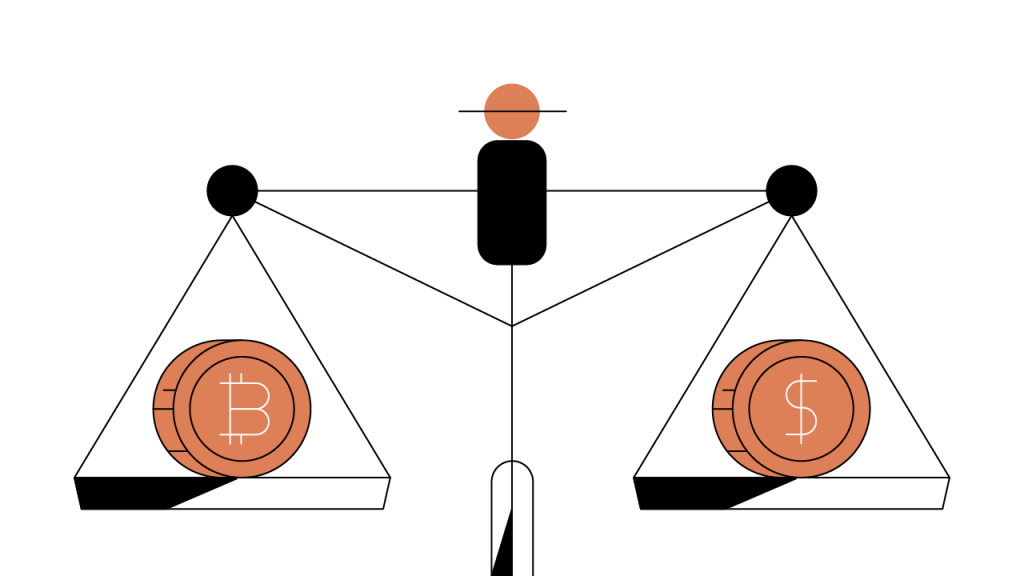Fiat vs. Crypto & Digital Currencies: Full Guide
From cowrie shells to crypto — the evolution of money and the rise of cryptocurrencies.
Updated April 21, 2025 • 4 min read

Summary
Any effective form of money must act as a medium of exchange, store of value, and unit of account. Both fiat money and cryptocurrency deliver this utility, but are different in a number of key ways. Fiat money is legal tender whose value is tied to a government-issued currency, like the U.S. dollar, while cryptocurrency is a digital asset that derives its value from its native blockchain. The issuance and governance of fiat currency are dictated by central banks, while blockchain protocols, code, and communities govern cryptocurrency. The distribution of fiat requires intermediaries, while cryptocurrency relies on distributed and decentralized networks to enable “trustless” transactions.
Money is a requirement of any financial transaction and is a collectively accepted representation of value around the world. In the earliest eras of civilization, societies denominated money in livestock like cows, goats, and camels. Then, everything from cowrie shells to salt saw widespread use as a form of money, before giving way to the more familiar form of precious metal coinage. Today, fiat money — government-issued legal tender with no intrinsic value — represents the most dominant iteration of money. For many, paper bills and coins are the only form of money they have ever known.
However, as history has shown us, money evolves, and its next stage is upon us. The emergence of blockchain technology and cryptocurrency over the last decade presents a foundational update to the world’s systems of money and value. Built on decentralized blockchain networks, digital currencies like bitcoin (BTC) and ether (ETH) are not controlled by a single governmental body and offer significant opportunities for financial inclusion worldwide.
What determines whether cryptocurrency is, in fact, money? It all comes down to satisfying three key criteria:
The Utility of Money
All effective forms of money must act as a store of value, medium of exchange, and unit of account. Without fulfilling these requirements, money cannot achieve scalable utility.
Store of value: All forms of money must act as a store of value. As such, there must be widespread confidence that money will retain its value. For instance, when a company issues a $100 invoice to a customer, it must be confident that the $100 has the same (or virtually the same) value 30 days out. Without value stability, there’s no incentive to use something as money, as the risk of devaluation is too high.
Although the majority of fiat currencies are reliable, there are many exceptions that are subject to currency inflation and ineffective monetary policy. And, while this early period of evolution in the cryptocurrency and blockchain space has been marked by significant market volatility, the emergence of stablecoins (price-stable digital assets with underlying collateral structures) strengthens the use case of digital currency as a store of value. Pegging cryptocurrency value to an underlying asset (fiat money, crypto, or a commodity) has brought a reliable store-of-value functionality to cryptocurrencies.
Medium of exchange: Money must be a widely accepted form of payment. Both sides in a transaction must share the perception of value. For example, let’s say someone offers to pay their babysitter in Monopoly money. Because Monopoly money has no perceived value (outside the context of a Monopoly game), the babysitter would not accept it as a form of payment.
Similarly, many were hesitant to accept cryptocurrency as a form of payment when it was first introduced in 2009. However, the rapid expansion and adoption of digital currency markets indicates a growing acceptance of cryptocurrency on both the individual and the institutional level. For example, in Fall 2020 PayPal began offering U.S. account holders the ability to trade some cryptocurrencies — Bitcoin, Ethereum, Bitcoin Cash, and Litecoin to start — and it plans to extend this service to select international markets in first-half 2021. While fiat currency remains the dominant medium of exchange, cryptocurrency is making up remarkable ground as more and more people begin to realize the value of digital assets.
Unit of account: To function as a unit of account, money must be able to price financial transactions by effectively denominating the value of different products and services throughout the economy in relation to each other. For example, a $500 mattress is more valuable than a $20 hat.
With fiat currency, monetary policy by central banks is used to manage the value of each currency in relation to others. By printing money or adjusting interest rates for borrowing, governments try to raise or lower the value of their fiat currency. The value of each crypto unit depends on prevailing crypto market prices.
To be a valid unit of account, each unit of money must also be divisible. For example, a fiat dollar can be broken down into quarters, dimes, nickels, and pennies. Cryptocurrency is particularly well suited towards divisibility because it is digital in nature. For example, BTC is divisible into units as small as one satoshi, which is one hundred millionth of a single bitcoin.
Beyond these requirements, money must also be durable, portable, uniform, limited in supply, and widely accepted. It’s apparent that the fiat money we use today meets all of these criteria, hence its universal use.
Issuance and Governance
A major criticism of fiat money is that it lacks intrinsic value, instead deriving perceivable worth from its status as legal tender. Fiat money’s value is inextricably linked to decisions made by central authorities, namely governments and central banks, regarding their monetary and fiscal policy. For fiat currency to be issued, a central bank simply gives the order.
Alternatively, cryptocurrency derives intrinsic value from its native blockchain, where monetary policies are transparent and written into the protocol’s codebase. While cryptocurrencies often have no fiscal policy, it is important to remember that their monetary policies are subject to the governance and consensus mechanisms of the protocol itself, rather than a single, central authority.
Most blockchain networks today rely on consensus mechanisms known as Proof of Work or Proof of Stake to mint new coins and many, but not all, have a finite supply of coins programmed into the protocol. Once minted or printed, both cryptocurrency and fiat currency can be purchased on exchanges and held as an investment, traded for other assets, or exchanged and spent in return for goods and services.
The Exchange of Value
Except for cash exchanges, transactions using fiat currency occur within the traditional banking infrastructure. In most cases, an intermediary is necessary to facilitate the exchange of funds between two parties. People who use credit cards or financial services apps to purchase groceries do so through payments technology companies like Visa or PayPal. People sending money to relatives in another country engage wire services merchants like Western Union to facilitate the transfer.
Transactions using cryptocurrency, however, occur via blockchain without the need for a centralized intermediary, instantly giving the system’s users more freedom. Transactions are validated and recorded by a distributed, decentralized network of participants by way of that blockchain protocol’s consensus mechanism.
Money Is Evolving
As history has proven, money and the systems that underpin it will continue to evolve. From cowrie shells to crypto, the form and technology may change, but the requirements and usage in regards to value, exchange, and accounting remain the same. While fiat currency is still the dominant form of money, cryptocurrencies and the blockchain technology that underpin them may very well represent the next step in the evolution of money.
Cryptopedia does not guarantee the reliability of the Site content and shall not be held liable for any errors, omissions, or inaccuracies. The opinions and views expressed in any Cryptopedia article are solely those of the author(s) and do not reflect the opinions of Gemini or its management. The information provided on the Site is for informational purposes only, and it does not constitute an endorsement of any of the products and services discussed or investment, financial, or trading advice. A qualified professional should be consulted prior to making financial decisions. Please visit our Cryptopedia Site Policy to learn more.

Is this article helpful?


